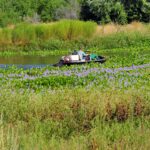At A&G Weed Control, we know that managing weeds effectively while protecting the environment is a top priority for landowners, farmers, and property managers. Traditional herbicides can be effective, but reliance on synthetic chemicals has raised concerns about herbicide resistance, soil health, and long-term sustainability. That’s where bioherbicides—natural weed control solutions derived from organisms or plant extracts—come in.
What Are Bioherbicides?
Bioherbicides are weed-control products made from naturally occurring microorganisms (such as fungi, bacteria, or viruses) or plant-based compounds like essential oils and organic acids. Unlike synthetic herbicides, which can leave residues in soil and water, bioherbicides offer an eco-friendly weed control option that aligns with sustainable land management practices.
Types of Bioherbicides for Eco-Friendly Weed Control
-
Microbial Bioherbicides: These use living organisms, such as specific fungi or bacteria, to target and suppress weeds.
-
Plant-Based Extracts: Natural compounds like clove oil, citric acid, or allelopathic plant chemicals that inhibit weed growth.
-
Biochemical Bioherbicides: Naturally occurring molecules, including fatty acids and organic acids, that break down quickly in the environment.
By diversifying weed control tools with these natural solutions, landowners can reduce reliance on synthetic herbicides while maintaining effective results.
Benefits of Bioherbicides for Weed Control
Choosing bioherbicides as part of your natural weed control strategy brings several advantages:
-
Environmentally Responsible – Minimal impact on soil, water, and pollinators.
-
Reduced Resistance Risk – Weeds are less likely to develop resistance compared to repeated use of synthetic herbicides.
-
Sustainable Practices – Aligns with organic and eco-friendly land management goals.
-
Integrated Flexibility – Works well in combination with mowing, mulching, and cover cropping.
At A&G Weed Control, we encourage clients to consider bioherbicides as part of a broader eco-friendly weed control program.
Limitations and Considerations
It’s important to note that bioherbicides are not a one-size-fits-all solution. They may act more slowly than chemical herbicides, and their effectiveness can depend on weather and soil conditions. Cost and availability also vary, but research and development are expanding quickly, bringing more practical options to market every year.
Real-World Applications
Several bioherbicides are already in use across agriculture, landscaping, and turf management. For example, microbial-based products have been developed to specifically target invasive broadleaf weeds, while plant-extract formulations are being applied to organic farms. These case studies show how bioherbicides can reduce chemical inputs without sacrificing weed control effectiveness.
How to Incorporate Bioherbicides Into Your Weed Management Plan
- Combine bioherbicides with proven practices like mulching, mowing, or crop rotation.
- Use them as part of an Integrated Weed Management (IWM) strategy for long-term results.
- Work with professionals like A&G Weed Control to evaluate your land and choose the best natural weed control options.
Bioherbicides represent an exciting step forward in sustainable weed management. By reducing dependence on synthetic herbicides, landowners can protect soil health, support biodiversity, and move toward more eco-friendly practices.






0 Comments